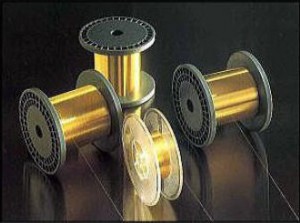Suzuki SP Wire for Wire-EDM
SP Strong like tungsten
Conductive like Brass
Less Cost
Available from 0.03mm
SP Wire Structure and Specifications
SP Wire Structure and Wire Geometry
SP Wire Specifications
| Product code |
Wire OD (mm) |
OD tolerance (mm) |
Tensile strength (N/mm2) |
Outer shell thickness (avg) (micro m) |
Electric conductivity (%) |
|---|---|---|---|---|---|
| SP30S | 0.03 | +0.000
-0.003 |
2160=.< | 1.5 | 13=.< |
| SP40S | 0.04 | 2.0 | |||
| SP50S | 0.05 | 2.5 | |||
| SP60S | 0.06 | 3.0 | |||
| SP70S | 0.07 | 3.5 | |||
| SP80S | 0.08 | 4.0 | |||
| SP100S | 0.10 | +0.000
-0.004 |
1960=.< | 5.0 |
.
SP Wire Length/Reel and Reel Dimensions
| Length/reel(m) | Product applicable |
Type of reel | Reel dimensions(mm) | ||||
|---|---|---|---|---|---|---|---|
| Flange | Barrel | Traverse | Total length |
Bore | |||
| 20,000 | SP100S – SP50S | Type A | 130 | 80 | 90 | 110 | 20 |
| 10,000 | SP100S – SP40S | Type A | 130 | 80 | 90 | 110 | 20 |
| 5,000 | SP100S – SP30S | Type A | 130 | 80 | 90 | 110 | 20 |
| 5,000 | SP100S – SP30S | Type B | 130 | 60 | 30 | 37 | 13 |
.
SP Wire Cutting Characteristics and Performance
ED Cutting Performance of SP Wire
- Cutting speed
Improvement of ≥10% over tungsten wire, thanks to SP wire’s high electrical conductivity. - Surface roughness
Due to its excellent ED stability and high tensile strength, SP provides a fine surface roughness as good or better than that of brass wire. - Cutting width (clearance)
With its high tensile strength and stable ED characteristics, SP wire provides precise, fine ED cutting where the cutting width (clearance)is ≥20% narrower and the corner radius is smaller than that with tungsten wire. Thus, the same machining accuracy can be obtained with one size larger SP wire, along with a much faster cutting speed. - Abrasion of wire guides
Since SP wire is flexible and has a soft and smooth surface, abrasion of the wire guides (electrified pins, guide rollers, etc.) of ED machines is far less than that with tungsten wire, reducing operating costs. - Automatic wire joining
SP wire has excellent free cast and straightness, allowing a high rate of automatic wire joining. - Longer continuous length
SP wire provides a longer continuous length per reel: 5,000m/reel, 10,000m/reel and 20,000m/reel, while that of tungsten wire is 3,000 – 5,000m/reel. Thus, longer continuous operation and higher productivity can be achieved. - Surface stability
Unlike tungsten wire, SP wire is invulnerable to surface oxidation. Remaining wire can therefore be used again easily. - HOMO phenomenon
The HOMO phenomenon, an unstable ED caused by the short-circuit, that occurs when cutting a tungsten-containing work piece (e.g., tungsten carbide) with a tungsten wore, does not occur with SP wire. - Cost performance
In addition to the excellent properties above, SP wire is far less expensive than tungsten wore, providing an excellent cost performance - An easy method for setting cutting conditions
To find the optimum cutting conditions for SP wire, first set the cutting conditions for a brass wire electrode having a diameter equal to SP wire. Then gradually increase the wire tension until the SP wire breaks. The optimum tension is that just before breakage.
You may also be able to obtain SP wire cutting condition data from ED machine manufacturers.

